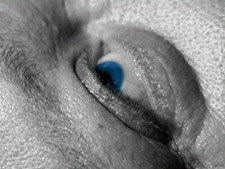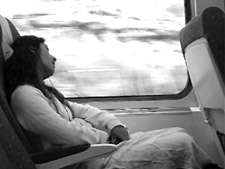Rodrigo Alonso
 |
|
 |
| Iván Marino. In Death’s Dream Kingdom. Net.art. 2003. |
 |
Mariela Yeregui. Topografías Desmesuradas. Net.art. 2003. |
 |
Two works of net.art incorporating the novel technology of "video-streaming" explore narrative possibilities hitherto unknown in the realms of Internet.
When massive access to Internet became a reality, in the early 1990's, the voices of its defenders resounded with familiar words. As in the years when home video appeared, stress was laid on the possibilities it offered for the production of a contracultural discourse, its independence of ideologists and corporations, the panacea of freedom won from the bombardment of the mass media. It took us only a few years to understand that Internet could be transformed into a medium as commercial and encyclopaedic as any other, and that a medium acquires autonomy only when it is capable of generating its own discourse.
Fortunately, our time is witnessing firm steps on that path. In the work of experimental artists, programmers and designers, the net is slowly but decidedly becoming peopled by proposals defying our perceptive, semantic, linguistic and narrative conceptions coined in the heat of the analogical media. In this very year, two works using "video streaming" (video transmitted in real time by the data networks) present us with a different approximation to the audiovisual universe of Internet. Exploiting to the maximum the particularities of interaction with audiovisual materials capable of being modified in real time, both proposals investigate the construction of open, unstable and non-linear narratives and zones of navigation, based on transitory configurations and on the decisive role of the user as co-author, strengthening the qualities of the net itself.
The works were designed for Playing Field (http://playingfield.net), a collaborative project among three European institutions aimed at investigating the possibilities of creation with streaming technology specifically for Internet. The results are promising, and doubtlessly they are key works tending towards a new concept of data networks, due not only to their technical achievements but also –and fundamentally– because of their degree of involvement in the structural particularities of the medium.
THE CONSTRUCTION OF THE AUTOR
The making of In Death's Dream Kingdom was based on video footage shot in a psychiatric hospital. The difficulty of constructing meaning, proper to the persons interned in the hospital constitutes a metaphor of the structure of the site itself, the framework of which depends on the erratic wanderings of the user. In its narrative organisation the work combines the discontinuity of the hyperlinks governed by the interactor with the linear structure of videographic registers, which make up a permanently present audiovisual background. This combination makes it possible to undermine the narrative sequentiality of video through manipulation strategies that transform its temporal flow into a malleable substance, both on perceptive and fictional construction levels and at the stage of building the story. In this way, the story –or rather, the possible stories– take place within a double "spatiality" (if the dimensional metaphor can be accepted): in the extension of the story line and in the depth opened up by each exploration of the site's links. To these "spaces" is added a third one that is even less precise: the presence of other visitors activates certain objects chromatically, signalling an element of involuntary narrative incidence with specific effects on the exploration.
In each incursion, the audiovisual fragments and the narrative tools extract an intimate personal tale from the public realm of the Internet. Enunciation is configured as a practice, and not as the unveiling of an implicit grammatical order. In this practice, what is constructed is an author, who can no longer be identified with the creators of the artwork but rather with the potentiality of the story in its manifestation. As Michel Foucault demonstrated, the subject of discourse is not external to it, but rather is jointly formed in the conditions of possibility permitted by the appearance of such a discourse. The enunciation creates a subject independent of body and consciousness, a narrative instance functioning as a node of semantic coherence, which in its instantaneous conformation sets itself apart from the impositions of the physical world.
The subject is clearly not the one completely responsible for its discourse imagined by modern thought; rather, it appears as the result of discursive formations corresponding to our own time, as in the case of Internet. One of the most interesting aspects of In Death's Dream Kingdomis precisely that it stresses this fact both in the particular way in which it functions and in that it remits this displaced subject to the terrain of psychiatric disorders. As with Jacques Lacan and Foucault, the hospital becomes the operating theatre for an examination of our environment.
EXTENSIONS AND CARTOGRAPHIES
In an interview at the end of the 1980's, the poet Audre Lorde said, "A map is drawn of where one has been. But as yet there is no map of the place to which we are going to." What would Audre Lorde have thought of Topografias Desmesuradas(Disproportionate Topographies), another of the interactive projects to be found in the Playing Fields site?
Basically, Topografias Desmesuradasis a map permanently under construction... A map or a territory? This is no minor question, if we return to the reflections on spatial metaphors so in tone with virtual productions that Erkki Huhtamo has described so clearly for the case of the CD-Rom: "Typical metaphors for describing the experience of using a CD-Rom –practically the same ones as those popularised for data networks– are travelling or navigating. They refer to a spatial experience, an interactive journey of discovery into the virtual world hidden on the disk, supposedly beyond the interface."
The particular feature of Topografias Desmesuradas is that it does not refer to a world external to the network itself. What it does propose is to colonise cyberspace, founding a territory the existence of which depends strictly on the conditions of the medium. Here we can see clearly the difference between this proposal and others developed for supports such as CD-Rom: this map can only be conceived in a medium with the guarantee of full interactivity. Within this site, users can create their own enclaves, in a map without apparent frontiers. In fact, the map grows as founders increase the number of settlements. The interventions take the form of "villages"; however, these take the identity not of their inhabitants but of their creator, who within the enclave can configure their own universe, supplying images, texts or marks, which will remain inalterable with the passage of time, though the map continues its transformation.
Once again, the field of the creation has been displaced from the authors of the artwork to the subject making a specific use of the possibilities available. In time, the original features of the map will be lost in unrecognisable geographies. The founders themselves will be unable to identify it, as villages can be displaced from their original location. But is not a map an instrument of location, a representation destined to ensure orientation, geographical consistency and ways of situating oneself when faced by the unknown? Does it make sense to speak of a map under these conditions, where we are dealing with a topographical figure unable to ensure its own stability?
In a sense, perhaps, this could be a true map of our time, a symbol of the disoriented action that echoes again and again in the contemporary life experience. Here, however, the uncertainty that would be an unbearable nightmare for philosophers, acquires a playful, creative character. Having overcome the stigmas of Baudrillard's simulacrum, representation recovers its productive value, inviting us once again to reflect on the worlds awaiting us where open and spontaneous collective creation lets us to undertake participative construction. |
Published in:
art.es. International Art Magazine. No 0. Madrid. November-December, 2003.
In Death’s Dream Kingdom
http://www.playingfield.net/ivan
Hyper-narrative environment for Internet based on streaming video
Direction: Iván Marino
Production: Iván Marino, Andrea Nacach, Luis Negrón
Topografías Desmesuradas
http://playingfield.net/
Collaborative net environment based on streaming video
Author: Mariela Yeregui
Programming: Mariano Sardón, Fabián Taranto
Graphic Concept: Andrea Nacach
|

